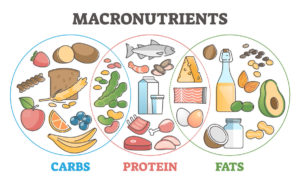
WHAT:
Protein is a macronutrient that contains about 4 calories per gram. Because of the energy demands of processing protein, it has a TEF (thermic effect of food) of about 30%, which means if you ate 10 calories worth of protein, your body would need to use about three calories to process it, which is much higher than body carbs and fats.
Protein sources can contain upwards of 20 amino acids, nine of which are essential to eat because our body can’t make them. This isn’t something most of us need to worry about when we are eating enough protein from varied sources.
WHY:
Protein is used in many of the body’s metabolic processes, as well as building new tissue. Having enough protein can help with recovery, improve performance, and increase muscle mass and strength when paired with fitness training.
Having a diet with sufficient protein has also been shown to be better for maintaining body weight, likely because it leaves people feeling full and has a higher TEF. This goes hand-in-hand with being excellent for fat-loss diets as well. Not only will you feel more full when eating protein, you get the benefits of protein’s ability to help maintain lean body tissues, and the higher TEF.
HOW:
A lot of people have a hard time eating enough protein even when they don’t need much. I suspect this is because many modern convenience foods contain meat and people assume they get enough protein from those. But most meat in those types of foods are highly processed, high in fat, high in carbs, so that they taste super good. I also have learned that many people are uncertain about what a good protein source is. For example, peanut butter is a high fat food source. Even though it does contain some protein, it’s not the best choice due to its high fat content.
When deciding how much protein to eat, a good range is 0.8g-1.2g per lb of lean body mass, depending on how often you exercise and what type of exercise you’re doing. A powerlifter lifting six times per week will need more protein than somebody who jogs for fun three to four times a week. To find your lean body mass, you can use many of the different measuring tools like a smart scale, or guess. Neither option may be 100% accurate, but you don’t need to be perfect. Subtract your fat mass from your total weight to get your lean body mass. (ex: body fat% = 20%, total body weight 200lbs)
(200-20%= Lean body mass estimate 160lbs) (eat about 160g of protein per day)
When picking your protein source, you want to be sure that the protein content compared to other macronutrients is higher. Keep some pre-cooked protein on hand. I like to cook a source or two that I know I’ll like for the week, and have one more processed source like deli meat or beef jerky for a snack incase I’m busy or want a snack. You can also do some plant based protein like chickpeas, or edamame. Remember to vary your food choice from time to time to ensure a robust nutrient intake. Finally, plan your meals around your protein source. If you make this a habit then you won’t have to worry much about getting adequate protein because it’ll be the first thing on your plate.
